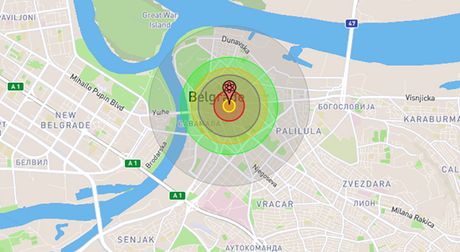What would happen to Belgrade if nuclear strike as powerful as the blast in Beirut happened downtown
The center of Belgrade would be completely devastated, turned into steam, dust and ruins, while all the glass would crack on buildings even in Slavija and Usce

The power of the explosion of a warehouse in the port of Beirut, which destroyed a huge part of this Lebanese city, is estimated at as many as 2.75 kilotons of TNT explosives. What would happen if a nuclear bomb of this magnitude exploded in Belgrade's Republic Square?
As the approximation on the Nukemap site shows (this is a simulation of a nuclear strike, not of a classic explosion), the center of Belgrade would be completely devastated, turned into steam, dust and ruins, while all glass would crack on buildings even in Slavija and Usce.
The very core of the explosion, the so-called "nuclear fireball" would not merely turn into dust, but literally evaporate the building of the National Museum and the National Theater, Staklenac, and even Palace Albanija.
In the second concentric circle, the destructive power would be so great that the bomb would easily destroy buildings, even those made of concrete, and almost all people who happened to be in that area would be killed. That would be the zone up to the Delijska fountain, the start of Skadalija, while the Politika building would be located just outside this destructive belt. There would be nothing left of Obilicev Venac, and the turnaround on Zeleni Venac would also be damaged.
Most residential buildings would be demolished in a wider circle, where there would be many more victims. Such a catastrophe would also hit Student Square, the Old Palace, while the Narodni Front maternity hospital would lie just outside it.
This is followed by a narrow belt where everyone exposed to the rays would suffer serious burns. But even in a wider circle, the chances of anyone surviving would be slim. We are talking about an approximation of a nuclear strike, which implies strong irradiation. Therefore, in the zone all the way to Kalemegdan, half of Branko's Bridge, the Bus Station, the Botanical Garden, the Church of St. Marko, the GSP depot on Dorcol... most people would be exposed to deadly rays, but they would die within a month. Whoever managed to survive would have a great chance of developing cancer.
Many injuries and horrific images would be seen in an even wider area. The glass on the buildings would crack, but not immediately. First a horrible flash would appear, people would approach the windows, and only then would there be a blow and the windows would shutter. This zone extends almost to the Vuk Monument, then to Usce, the Nebojsa Tower, the Dunav Station and Slavija.
Some smaller towns, such as Valjevo, would be completely destroyed.
Video: All the horror of the explosion in Beirut: The port is destroyed
Video: Bloodied citizens of Beirut run through the streets after the terrible explosion
(Telegraf.rs/Telegraf.co.uk)
Telegraf.rs zadržava sva prava nad sadržajem. Za preuzimanje sadržaja pogledajte uputstva na stranici Uslovi korišćenja.




